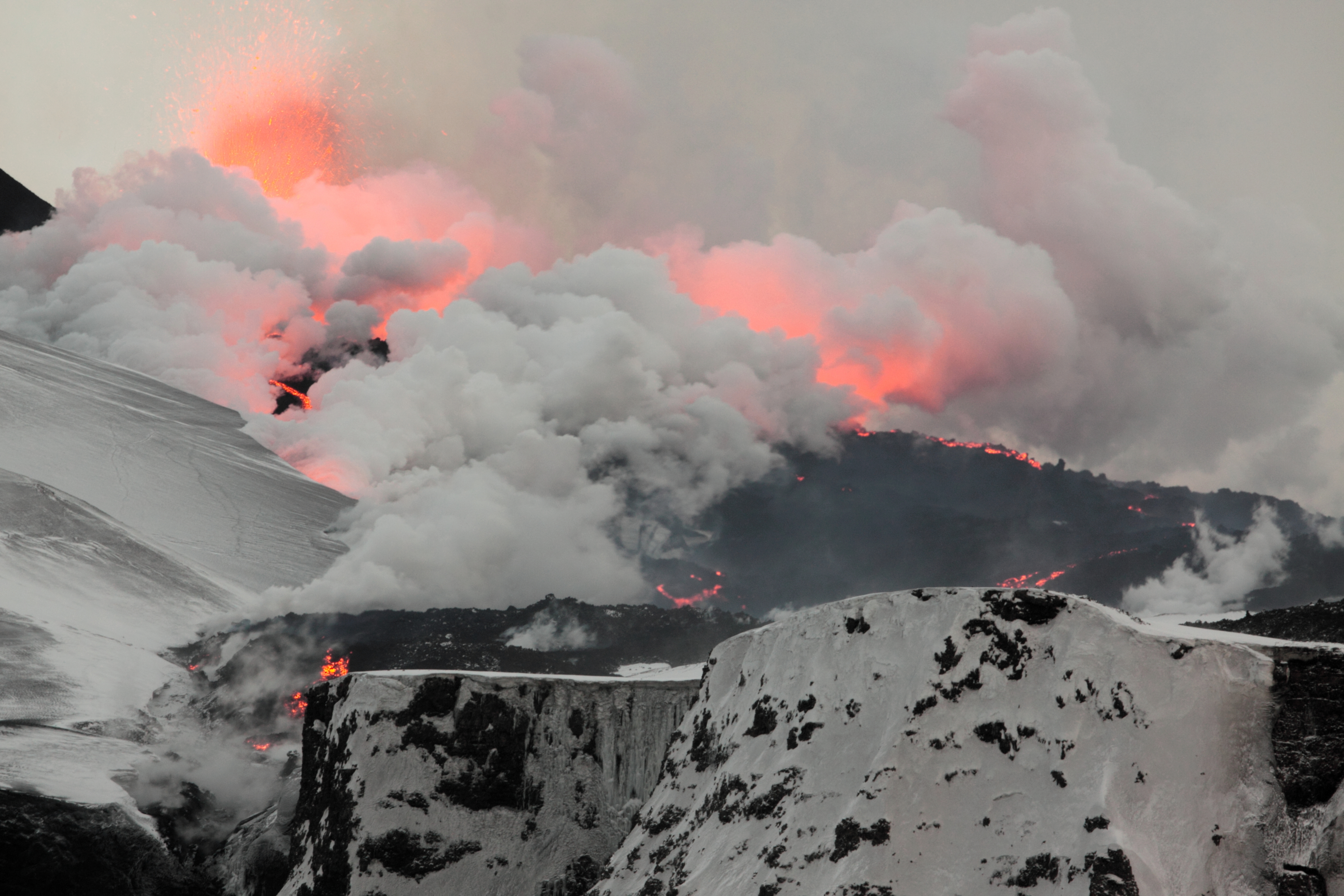Fimmvörðuháls on:
[Wikipedia]
[Google]
[Amazon]
 Fimmvörðuháls (; "five cairns pass") is the area between the glaciers
Fimmvörðuháls (; "five cairns pass") is the area between the glaciers

 On 20 March 2010, an
On 20 March 2010, an
Location of the eruption on Fimmvörðuháls/Eyjafjallajökull
Southern Region (Iceland) Hiking trails in Iceland {{Iceland-geo-stub fi:Fimmvörðuháls
 Fimmvörðuháls (; "five cairns pass") is the area between the glaciers
Fimmvörðuháls (; "five cairns pass") is the area between the glaciers Eyjafjallajökull
Eyjafjallajökull (; ), sometimes referred to by the numeronym E15, is one of the smaller ice caps of Iceland, north of Skógar and west of Mýrdalsjökull. The ice cap covers the caldera of a volcano with a summit elevation of . The volcan ...
and Mýrdalsjökull
Mýrdalsjökull (pronounced , Icelandic for "(the) mire dale glacier" or "(the) mire valley glacier") is an ice cap in the south of Iceland. It is to the north of Vík í Mýrdal and to the east of the smaller ice cap Eyjafjallajökull. Between t ...
in southern Iceland
Iceland ( is, Ísland; ) is a Nordic island country in the North Atlantic Ocean and in the Arctic Ocean. Iceland is the most sparsely populated country in Europe. Iceland's capital and largest city is Reykjavík, which (along with its s ...
. The route between Skógar
Skógar (pronounced ), literally "forests", is a small Icelandic village with a population of roughly 25 located at the south of the Eyjafjallajökull glacier, in the municipality of Rangárþing eystra.
The area is known for its waterfall, Skóg ...
and Thórsmörk goes through this pass and is one of the most popular walking routes in Iceland, despite being long and involving of climbing. There are two mountain huts along Fimmvörðuháls, one owned by hiking association Útivist, the other called Baldvinsskáli (). The route from Skógar has many waterfalls along the way. The route is only accessible between mid-June and late-August. On the night of 16 May 1970, three travellers died in the mountain pass in a snowstorm.
Hiking the Fimmvörðuháls mountain pass takes 1–2 days. It is also possible to combine the Fimmvörðuháls route with the Laugavegur Trek between Landmannalaugar
Landmannalaugar () is a location in Iceland's Fjallabak Nature Reserve in the Highlands. It is at the edge of the Laugahraun lava field, formed in an eruption in approximately 1477. It is known for its natural geothermal hot springs and ...
and Thórsmörk to make a trip of 4–6 days in length.
2010 eruption

eruption
Several types of volcanic eruptions—during which lava, tephra (ash, lapilli, volcanic bombs and volcanic blocks), and assorted gases are expelled from a volcanic vent or fissure—have been distinguished by volcanologists. These are often ...
of the Eyjafjallajökull
Eyjafjallajökull (; ), sometimes referred to by the numeronym E15, is one of the smaller ice caps of Iceland, north of Skógar and west of Mýrdalsjökull. The ice cap covers the caldera of a volcano with a summit elevation of . The volcan ...
volcano
A volcano is a rupture in the crust of a planetary-mass object, such as Earth, that allows hot lava, volcanic ash, and gases to escape from a magma chamber below the surface.
On Earth, volcanoes are most often found where tectonic plates are ...
began in Fimmvörðuháls following months of small earthquake
An earthquake (also known as a quake, tremor or temblor) is the shaking of the surface of the Earth resulting from a sudden release of energy in the Earth's lithosphere that creates seismic waves. Earthquakes can range in intensity, from ...
s under the Eyjafjallajökull glacier. The eruption began around 23:00 and opened a long fissure vent
A fissure vent, also known as a volcanic fissure, eruption fissure or simply a fissure, is a linear volcanic vent through which lava erupts, usually without any explosive eruption, explosive activity. The vent is often a few metres wide an ...
on the northern part of the pass.
Just over a week later, the Fimmvörðuháls eruption produced a -long fissure and new craters were seen erupting on a northward path
toward the area of Thórsmörk, a popular tourist nature preserve
A nature reserve (also known as a wildlife refuge, wildlife sanctuary, biosphere reserve or bioreserve, natural or nature preserve, or nature conservation area) is a protected area of importance for flora, fauna, or features of geological or o ...
, prompting tours to stop briefly as volcanologist
A volcanologist, or volcano scientist, is a geologist who focuses on understanding the formation and eruptive activity of volcanoes. Volcanologists frequently visit volcanoes, sometimes active ones, to observe and monitor volcanic eruptions, col ...
s assessed the situation further. The two new craters at Fimmvörduháls were named Magni and Móði, after the sons of Thor
Thor (; from non, Þórr ) is a prominent god in Germanic paganism. In Norse mythology, he is a hammer-wielding æsir, god associated with lightning, thunder, storms, sacred trees and groves in Germanic paganism and mythology, sacred groves ...
, the Norse god of thunder. It is an apt name because Thórsmörk is close to the craters. The new lava field was named Goðahraun, because the lava streamed in the area Goðaland. These official names were accepted by the Minister of Education and Culture 15 June 2010.
In April 2010, this was followed by a larger eruption on Eyjafjallajökull
Eyjafjallajökull (; ), sometimes referred to by the numeronym E15, is one of the smaller ice caps of Iceland, north of Skógar and west of Mýrdalsjökull. The ice cap covers the caldera of a volcano with a summit elevation of . The volcan ...
itself.
References
External links
Location of the eruption on Fimmvörðuháls/Eyjafjallajökull
Southern Region (Iceland) Hiking trails in Iceland {{Iceland-geo-stub fi:Fimmvörðuháls